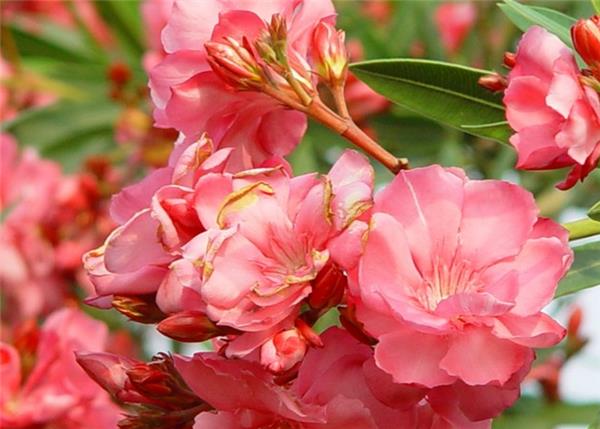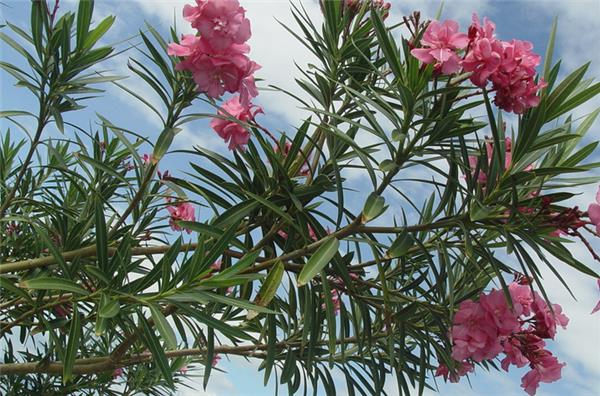How to breed oleander
Oleander, also known as willow leaf peach, half a year red, originated in India, Iran nuclear Afghanistan. Oleander is named because of its leaves such as willows, flowers such as peaches and mostly pink and white. Oleander can be evergreen three seasons a year, and from spring, summer and autumn, the flowers bloom and fall, and it has a strong adaptability to the environment, regardless of wind, rain or hot sun, it can always reveal its fragrance, so it is also one of the ornamental flowers and trees often planted in the courtyard.

Is oleander poisonous?
In fact, oleander is a highly poisonous plant, and it is one of the most poisonous plants in the world. It contains many kinds of toxins, even deadly toxins. The toxins in oleander tree sap can cause skin paralysis. The concentration of venom is the highest in the whole plant, and the bark of oleander also contains toxins. Oleander is toxic for a long time, even in dry branches, so the smoke from burning oleander is highly toxic. Oleander can only bring adverse reactions to adults, a single leaf can lead to the death of babies with low resistance, so pay attention to the toxicity of oleander when planting oleander.
The origin of the toxicity of oleander also comes from a legend: according to the legend, oleander begins to be white, and beautiful princesses like to plant oleander and plant oleander in their own palace. The beginning of the tragedy is that the beautiful princess fell in love with her retainer, but suffered opposition from the family. The fragile princess chose to die with her lover, but the retainer did not really like her. The retainer was only for profit. The sad princess committed suicide under her beloved oleander after knowing the truth. A person's blood was stained with oleander, and the intense poison generated by the princess's resentment grew with the roots. In full bloom in the world.
2. Cultivation techniques of oleander
Oleander has strong adaptability, easy cultivation and management, and is relatively extensive no matter in the field or in the pot. In the place where the ground is planted, transplanting should be carried out in spring, and re-cutting should be carried out when transplanting. Pay attention to protection in winter. Branches and leaves are vulnerable to scale insects, so attention should be paid to prevention and control.
Potted oleander requires not only good drainage, but also sufficient fertility. Spring germination needs shaping and pruning, the overgrown branches and delicate branches in the plant can be cut off from the base, the dense branches in the inner chamber should also be sparsely cut, and at the same time, the wound and anti-corrosion film should be smeared on the pruning mouth to protect the wound, so that the branches can be evenly distributed and the tree shape can be kept plump. After 1 ~ 2 years, the basin was changed once, and the basin should be changed after pruning. Summer is the period of vigorous growth and flowering of oleander, which requires a lot of water. In addition to watering each day in the morning and evening, if the pot soil is too dry, one more spray should be added to prevent the twigs from wilting and affecting the flower life. After September, water should be deducted to inhibit the continued growth of the plant, make the branch tissue mature and increase the accumulation of nutrients in order to survive the winter safely. The overwintering temperature should be maintained at 8 ℃ ~ 10 ℃. When the temperature is lower than 0 ℃, oleander leaves will fall. Oleander is a fertilizer-loving plant, which should be applied once a month during the growing period in addition to sufficient basal fertilizer.

Third, the function of oleander
1. Watch. Oleander leaves such as willow bamboo, red flowers burning, better than peach blossoms, Corolla pink to crimson or white, with a special aroma, flowering from June to October, is a famous ornamental flower.
2. Purify the air. Oleander has the ability to resist smoke, dust, poison, purify the air and protect the environment. Oleander leaves are toxic to the human body and have strong resistance to harmful gases such as sulfur dioxide, carbon dioxide, hydrogen fluoride and chlorine. According to the determination, the oleander planted in the pot was only slightly damaged at 40 meters from the pollution source, but basically harmless at 170 meters, and could still blossom normally, and the sulfur content in its leaves was more than 7 times higher than that of the uncontaminated ones. Oleander, even if covered with dust, can still grow vigorously, and is called the "guardian of environmental protection".
3. Medicinal use
Modern medical research has proved that oleander leaves contain oleander glycosides, glycosides and other substances, and flowers contain digitalis glycosides, aglycone, peach glycosides and other components. They have significant cardiotonic and diuretic, sweating, emetic and analgesic effects, and their effects are similar to digitalis and belong to chronic cardiotonic glycosides. It is reported that the water decoction of oleander is suitable for heart failure caused by various causes and achieved good results. Oleander bitter cold, toxic, can be used for the treatment of heart disease, heart failure, amenorrhea, can also be used for fall injury, blood stasis swelling pain and other diseases.

Oleander is beautiful like peach blossom and tough like a pillar. In the beautiful face and sad story, you can experience the beauty and tenacity that belongs to oleander alone. Oleander is a poisonous plant, so I hope to pay more attention to it when planting.
Oleander is beautiful like peach blossom and tough like a pillar. In the beautiful face and sad story, you can experience the beauty and tenacity that belongs to oleander alone. Oleander is a poisonous plant, so I hope to pay more attention to it when planting.
Related
- Wuhan Hospital Iron Tree Blooming Result Was Instantly Frightened by the Gardener Master
- Which variety of camellia is the most fragrant and best? Which one do you like best?
- What is the small blue coat, the breeding methods and matters needing attention of the succulent plant
- Dormancy time and maintenance management of succulent plants during dormancy
- Minas succulent how to raise, Minas succulent plant pictures
- What are the varieties of winter succulent plants
- How to raise succulent plants in twelve rolls? let's take a look at some experience of breeding twelve rolls.
- Attention should be paid to water control for succulent plants during dormant period (winter and summer)
- Watering experience of twelve rolls of succulent plants
- Techniques for fertilizing succulent plants. An article will let you know how to fertilize succulent plants.



